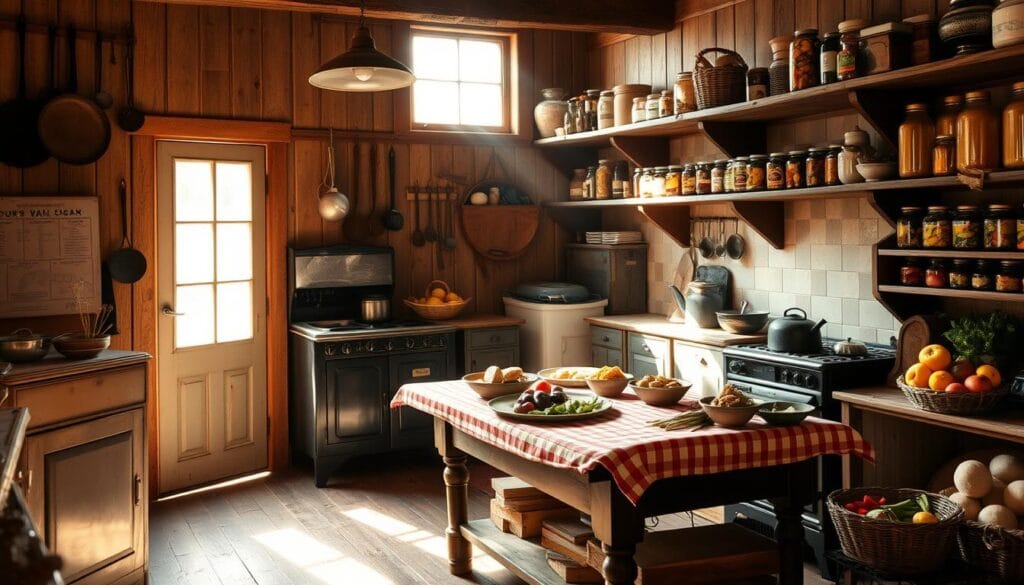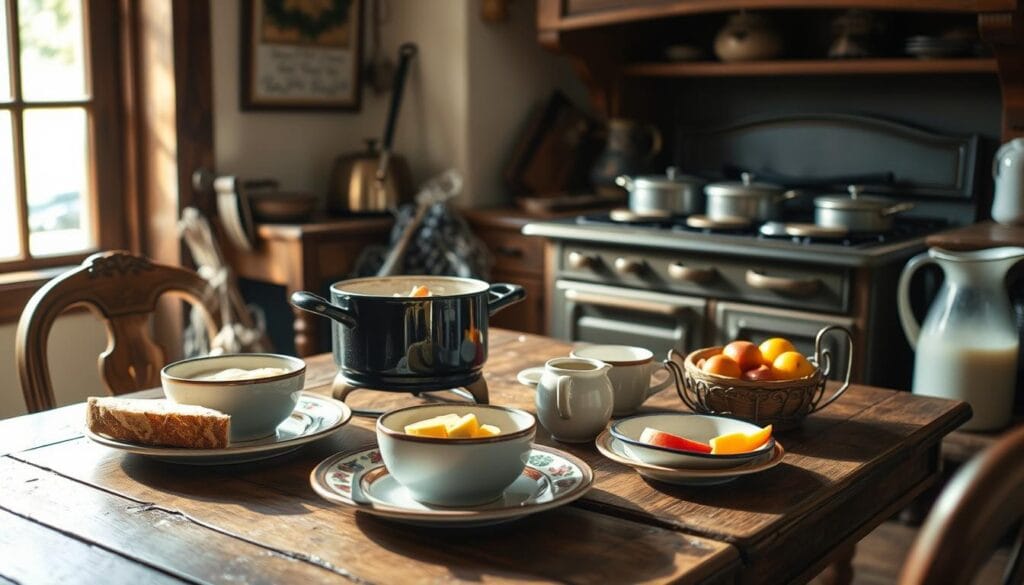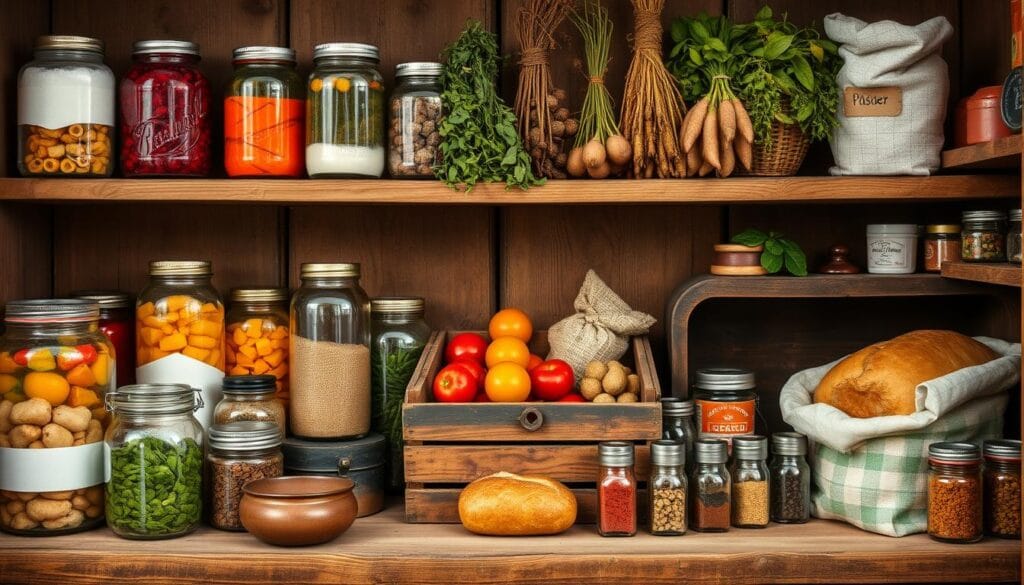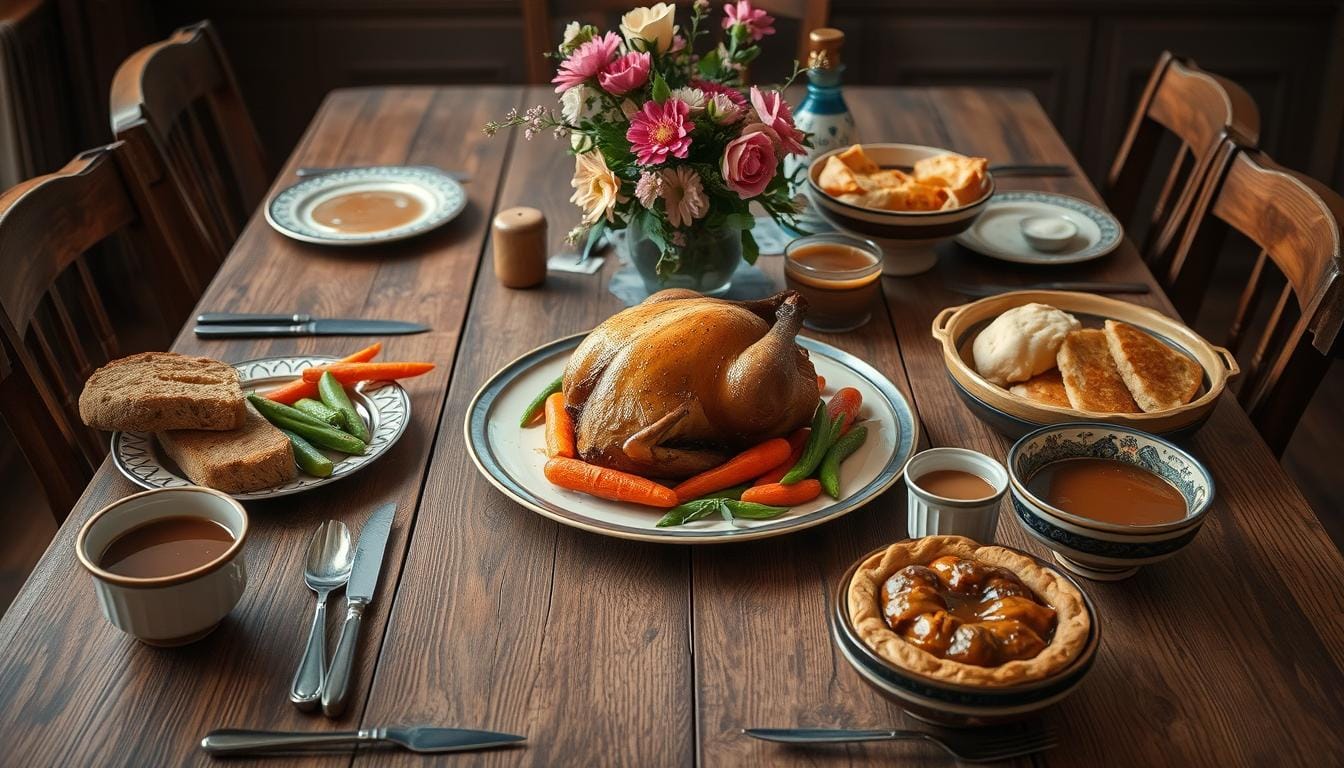Exploring American dining in the early 20th century, you might ask, “What was a typical meal in 1910?” The era blended traditional and ethnic cuisines. Italian-style pizzerias in New York City and the Home Economics movement significantly influenced dining habits.
Typical meals featured a variety of foods, such as melons, vegetable hash, and broiled veal cutlets, all shaped by the season and local ingredients.
In the 1910s, grocery stores carried about 1,000 items—far fewer than today’s 30,000. Yet this period introduced iconic foods like Jell-O, Crisco, and Oreos.
Discovering what people ate in 1910 reveals a fascinating mix of innovation and tradition that defined American meals during this time.
The American Kitchen in 1910
The kitchens of 1910 were centers of activity and simplicity. Equipped with wood-burning stoves, coal ovens, and basic tools like cast-iron skillets and utensils, meals were a labor-intensive endeavor. Iceboxes and root cellars were vital for food storage, reflecting the era’s resourcefulness.
Families relied heavily on local produce and pantry staples. For an in-depth look at breakfast customs during this time, explore Breakfast in 1910 – What Did People Eat? to see how early mornings set the tone for the day.
Some key features of the American kitchen in 1910 include:
- Basic kitchen equipment such as pots, pans, and utensils
- Food storage methods like iceboxes and root cellars
- Cooking heat sources including wood-burning stoves and coal-fired ovens

In 1910, meals were made with traditional recipes, like Shrimp in Ramekins. This dish needed a roux and milk. The early 1910s also saw more food diversity because of high immigration. Exploring the American kitchen of 1910, you’ll find a mix of old cooking ways and new trends.
| Year | Kitchen Equipment | Food Storage | Cooking Heat Sources |
|---|---|---|---|
| 1910 | Pots, pans, utensils | Iceboxes, root cellars | Wood-burning stoves, coal-fired ovens |
Breakfast Customs and Popular Morning Dishes
Exploring breakfast customs in 1910 reveals a variety of popular dishes. Breakfast customs often included hearty meals like eggs, beef sausage, and toast. These meals gave people the energy needed for a day’s work.
In the 1910s, popular morning dishes like Curried Egg Sandwiches were trendy. These sandwiches featured hard-boiled eggs, curry powder, and bread. They showed the simplicity and resourcefulness of American cooking back then. Favorites also included pancakes, hotcakes, and French toast, often served with fresh fruits, syrups, or honey.

Breakfast cereals were also a big part of 1910’s breakfast customs. Dr. James Caleb Jackson created granula in 1863. The Quaker Oat Company introduced Puffed Wheat and Puffed Rice cereals in the 1910s. These cereals became popular
Here are some interesting facts about breakfast customs in 1910:
- The first mention of hash browns dates back to 1835.
- Pancakes are one of the oldest breakfast foods, with ties to the last meals of natural mummies.
- The American version of the French parfait, which includes layers of yogurt, fruit, and granola, differs significantly from its French predecessor.
These breakfast customs and popular morning dishes of 1910 show how work demands influenced breakfast choices. They continue to shape American breakfast habits today.
Common Ingredients Found in 1910 Pantries
In 1910, a typical pantry had staples like flour, sugar, coffee, tea, and salt. These were key for making meals. It also had dried and preserved foods, like canned goods and pickled veggies.
Fresh produce was available, but it varied with the season. Spices and citrus fruits, imported from abroad, added flavor and variety to meals. Canned goods became more popular, growing by 50% from the 1900s.
Dried and Preserved Foods
Dry beans and peas were common, with a 20% increase in use. This was due to their nutritional value. About 90% of families used dairy products like milk and butter in their diets.
Fresh Produce and Seasonality
Fruits and vegetables were found in many homes, with 40% having some fresh produce. This showed a shift towards better eating habitsg. Families usually ate dinner together, around 6 p.m. to 7 p.m., after about 45 minutes of meal prep.
Imported Items
Spices and citrus fruits, imported from abroad, were key for making popular dishes. The arrival of packaged foods like Crisco, Domino sugar, Jell-O, and Kellogg’s Cornflakes also changed how meals were made and eaten.

What Was a Typical Meal in 1910 America?
In 1910 America, meals were simple yet hearty. They showed the resourcefulness and simplicity of American cuisine back then. Dishes like Shrimp in Ramekins and Vichyssoise were favorites. These meals used local ingredients, highlighting early 20th-century culinary trends.
Side dishes of the 1910s included watermelon, corn, and sweet potatoes. Stuffed eggs were a thing before deviled eggs came along. Flavors were simple and plain, typical of early 1900s cuisine. American cuisine was also shaped by companies like Nabisco and Kraft, making convenience foods popular.
The meal style in 1910 America varied from fancy to simple and canned. This was due to the economic conditions, with many facing limited access to fresh food, mainly in winter. The rise of canned goods and new products like Oreos and Kraft Processed Cheese also marked the era.
Recipes like the curried egg sandwich and Ambrosia used fresh ingredients and simple flavors. The typical meal in 1910 America showed the country’s culinary heritage. It focused on simplicity, resourcefulness, and local ingredients. Exploring American cuisine in 1910 reveals a mix of traditional and innovative dishes that defined the era.
| Recipe | Year Introduced | Ingredients |
|---|---|---|
| Shrimp in Ramekins | 1910s | Shrimp, cream, butter |
| Vichyssoise | 1917 | Leeks, potatoes, cream |
| Curried Egg Sandwich | 1912 | Eggs, bread, butter, curry powder |
Dining Customs and Table Etiquette
In 1910, dining was a big deal. It showed off your social standing. You had to know how to set the table and use your utensils right. This made dining a classy and fun experience.
At dinner parties, you’d find your seat with a place card. Each guest had a set of utensils and glasses for wine. Table etiquette was strict. You used a spoon for soup and a fish knife and fork for fish.
Some key dining customs in 1910 include:
- Dinner was from 8 PM to 9 PM. Guests arrived 15 minutes early.
- Invitations went out three weeks in advance. By 1910, it was four to six weeks.
- Hosts usually invited more men than women, but an equal number was preferred.
The way Americans ate changed over time. Before 1840, they used the American style. But by 1910, the European style was more common. This style didn’t let you switch utensils between hands. Knowing these table etiquette rules helps us understand 1910’s social norms and values.
| Aspect of Dining Customs | Description |
|---|---|
| Table Settings | Place cards, soup spoon, fish knife and fork, two knives, two large forks, and glasses for various wines. |
| Serving Practices | Eating soup with a spoon, fish with a fish knife and fork, and following a specific order of courses. |
| Dining Room Customs | Seating arrangements, invitation notice periods, and the importance of punctuality. |
Popular Cooking Methods of the Era
In 1910, American food was known for its popular cooking methods that were both simple and tasty. People often roasted, boiled, and fried their meals. These ways of cooking helped make dishes like roast beef and Franconia potatoes, which were favorites in many homes.
One big thing about American cuisine back then was the use of canned food. Canned shrimp was a big deal and was used a lot in cooking. Meals like shrimp in ramekins could be made in under 10 minutes, showing how people liked quick and easy food. Here are some key traits of cooking in 1910:
- Use of local and seasonal ingredients
- Simple and hearty dishes
- Incorporation of canned food
- Quick and easy meal solutions
These popular cooking methods showed the resourcefulness and simplicity of early 20th-century American cooking. They also helped shape modern American cuisine. By learning about these traditional ways of cooking, we can see how American food has evolved and how it continues to shape our food today.
| Dish | Preparation Time | Servings |
|---|---|---|
| Shrimp in Ramekins | Less than 10 minutes | 4-6 |
| Roast Beef and Franconia Potatoes | 1-2 hours | 6-8 |
| Canned Shrimp Salad | 10-15 minutes | 4-6 |
Regional Differences in American Cuisine of 1910
Exploring American cuisine in 1910 shows big regional differences. These differences come from the country’s diverse cultures and landscapes. The American cuisine of that time was influenced by climate, geography, and cultural exchange.
In 1910, what people ate varied by where they lived. The Northeast loved shellfish, while the Midwest was all about beef. Bread was a big part of meals, with white bread becoming more popular.
The South focused on local foods like corn, biscuits, and Beef sausage. They used spices like cayenne and black pepper to add flavor. Breakfasts also differed, with pancakes in the Midwest and oatmeal and grits in the Northeast and South.
| Region | Predominant Protein Sources | Staple Foods |
|---|---|---|
| Northeast | Shellfish | White bread, clam chowder |
| Midwest | Beef | Pancakes, bread |
| South | Beef sausage, corn | Biscuits, grits |
These regional differences in American cuisine of 1910 show the country’s rich and varied food heritage. It’s a result of different cultures and landscapes across the nation.
For instance, Memphis BBQ in the South was gaining prominence with its smoky, tangy flavors. Learn more about this regional specialty by visiting What Makes Memphis BBQ Different?.
The Impact of Immigration on American Meals
Exploring American cuisine history shows the big impact of immigration. In 1910, the U.S. was a mix of cultures. People from many countries brought their food traditions. This mix is seen in dishes like Curried Egg Sandwiches, showing how international flavors shaped American meals.
The impact of immigration is clear in how cultures helped grow American food. For instance, the “Three Sisters” (beans, corn, squash) were key in Native American diets. The Columbian Exchange also brought new foods like pigs and oranges. These added to the mix, creating unique flavors and dishes in 1910.
- Chinese dishes, like chop suey, became popular in the early 1900s
- Italian food introduced pasta, pizza, and more to American tables
- Mexican cuisine brought tacos, burritos, and other tasty dishes to the U.S.
These international flavors have made American cuisine rich and varied. Today, we enjoy a culinary world shaped by these influences.
Special Occasion Dining and Holiday Meals
In 1910, dining for special occasions was fancy and formal. Traditional dishes and customs were key. Orange Fool was a favorite at these events.
Holiday meals in 1910 featured roast beef, turkey, and Beef sausage. Sides included mashed potatoes, turnips, and pies. Christmas menus varied by region and budget.
At special occasions, presentation and abundance mattered a lot. A Christmas dinner might have 10-15 dishes. This showed a cozy, homey approach to festive eating.
Popular Christmas foods in pioneer America included:
- Roast beef
- Turkey
- Beef sausage
- Potatoes
- Pickles
- Various pies
These dishes show the importance of food and welcome in American culture. They highlight the joy of special occasion dining and holiday meals.
Conclusion: Understanding Our Culinary Heritage
Exploring the culinary traditions of 1910 shows us the value of culinary heritage in American cuisine. The meals of that time were simple, resourceful, and diverse. They show how our ancestors were clever and adaptable.
By learning about the 1910 kitchen and its tools, we can make new dishes. These dishes honor our past and show our modern tastes.
This journey through history makes us appreciate how American food has changed. It shows us the old traditions and the new ideas that have shaped our food. This knowledge helps us enjoy our culinary history and inspires us to create new dishes.
FAQ
Q: What was a typical meal in 1910 America?
A: A typical meal in 1910 America was simple and hearty. Dishes like Shrimp in Ramekins and Vichyssoise were common. These meals used local ingredients, showing the resourcefulness of early 20th-century American cooking.
Q: What was the American kitchen like in 1910?
A: The American kitchen in 1910 had basic tools and equipment. Pots, pans, and utensils were standard. Food was stored in iceboxes and root cellars. Cooking was done on wood-burning stoves and coal-fired ovens.
Q: What were some popular breakfast customs and dishes in 1910?
A: Breakfasts in 1910 were hearty, with dishes like eggs, beef sausage, and toast. A favorite was the Curried Egg Sandwich, made with hard-boiled eggs, curry powder, and bread.
Q: What kinds of ingredients were commonly found in 1910 pantries?
A: Pantries in 1910 had common ingredients like canned goods and pickled vegetables. Fresh produce was available, but seasonal. Spices and citrus fruits, imported, added flavor and variety.
Q: What were some popular cooking methods in 1910?
A: Popular cooking methods in 1910 included roasting, boiling, and frying. These were used for simple dishes like Shrimp in Ramekins, which needed a roux and milk.
Q: How did regional differences shape American cuisine in 1910?
A: Regional differences in 1910 American cuisine showed the country’s diverse culture and geography. East Coast, Midwestern, and Southern cooking all added to America’s rich culinary heritage.
Q: How did immigration impact American meals in 1910?
A: Immigration greatly influenced American meals in 1910. Immigrants brought their cooking traditions, like curried egg sandwiches. This diversity enriched American cuisine.
Q: What were some special occasion dining and holiday meal customs in 1910?
A: Special occasion dining in 1910 was elaborate and formal. Traditional dishes were served at Sunday dinners and holidays. These meals brought families and communities together.

